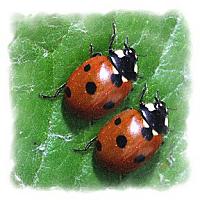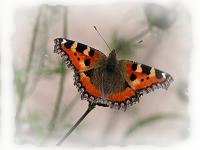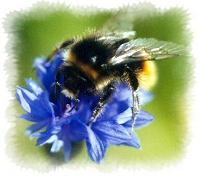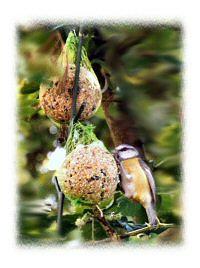

The English Cottage Garden Nursery Ltd.
Eggarton Cottages
Eggarton Lane
Godmersham
Kent CT4 7DY
UK
Not open to the public
 01227 730242 01227 730242

Registered in the UK,
Reg no. 6807584
FERA seed registration number 7258
|

 Payments made online are processed via WorldPay, using 128 bit encryption and secure server
Payments made online are processed via WorldPay, using 128 bit encryption and secure server
|

|
|
|



|
Wildlife Gardening
To ensure a good variety of wildlife visitors to your garden, you need
to ensure a good supply of appropriate nectar and food plants, and also
suitable habitats. The most suitable plants are listed below, plus the
visitors they may attract. An abundance of wildflowers will make your
garden the best wildlife restaurant in town! Providing a good native hedge
will also provide suitable habitats for birds and small mammals. Also,
do not tidy up the garden too much in winter - ladybirds and lacewings
(major devourers of garden pests) like to overwinter in hollow flower
stems, twigs, leaves and debris (as do many other insects). Hoverflies
are also good aphid and pest eaters and particularly like yellow and gold-coloured
plants. One important fact to remember in the wildlife garden is to NEVER
use pesticides or herbicides - if you do you will kill off any wildlife
you may have attracted.
Butterflies and Moths
Butterflies and moths are attracted by a wide variety of plants, both
wildflowers, herbs and the more traditional cottage garden plants. It
is also a good idea to have a small nettle patch to attract Small Tortoiseshell
and Peacock butterflies, who like to lay their eggs on the undersides
of the leaves. Cut the nettles back by half in mid-summer to encourage
new shoots for the next brood of caterpillars.
Some Good Butterfly and Moth Plants
Butterfly Plants
Moth Plants
Bees
There are more than 250 species of native bee in Britain, including 19
species of bumblebee - 25% of which are now endangered. In the last four
years or so, one species of bumblebee has been declared extinct and another
has become extinct along the south coast. Today, only 6 out of 16 species
are easily found and even these have declined in numbers. Bumblebees are
beneficial to farmers because of their importance in pollination, although
it is, ironically, the reduction in suitable farmland habitat by these
farmers that has aided the decline of the bumblebee. The Bumblebee Working
Group and English Nature are encouraging farmers to allow or provide White
Deadnettle growth in hedgerows, establish Red Clover in field margins
(very important bumblebee plant), and to leave field margins uncultivated
for a few years in order to provide hibernation sites and forage areas.
Gardeners can do their bit too by providing a small meadow area in their
gardens and leaving an area of rough grass, preferably by a hedge, for
mice or voles to nest in - what's this got to do with bees? Queen bumblebees
like to nest in old mouse and vole nests. You can also buy bee nesting
cylinders to attract Red Mason bees, who are excellent pollinators and
non-aggressive. You can also buy special boxes for bumblebees to nest
in. Interesting fact - a bumblebee can carry up to 60% of its body weight
in pollen.
Some Good Bee Plants
Bee Plants
|
|
Birds
Birds are easy to cater for! Bird tables and feeders are easily found
in shops and can be filled with seeds or peanuts to attract a variety
of birds. Don't forget to sprinkle food on the ground for birds such as
thrushes and dunnocks who like to feed at ground level. Peanuts will attract
tits, greenfinches and woodpeckers, but ensure you buy them from reputable
suppliers who will only sell peanuts free from Aflotoxin. Thrushes like
rotting apples, and half a coconut hung up will be popular with nuthatches.
Don't forget to keep the birdbath full of water for both feeding and bathing.
With regard to bird-friendly plants, leave as many plants as possible
to go to seed for they will provide seeds for the birds to eat. Again,
wildflowers are your best choice here. Cooked potatoes, rice, bread and
pasta are also popular. Remember to clean the bird table regularly and
to keep feeding once you start - the birds that come to visit you will
rely on you and come back every day.
What to Feed Garden Birds
Small Mammals
Please click here for information on attracting small mammals in to your garden.
Ponds
Ponds are important wildlife habitats.
for information on creating a wildlife pond, click here.
If you find you just cannot choose what to grow, why not choose one of our
Collections, where we will do the choosing for you! - Collections available
are :
Meadows are also excellent for attracting and sustaining wildlife.
Visit our meadows section to learn how you can create a meadow or meadow area in your garden.
|
|
|
 01227 730242
01227 730242
 Payments made online are processed via WorldPay, using 128 bit encryption and secure server
Payments made online are processed via WorldPay, using 128 bit encryption and secure server






